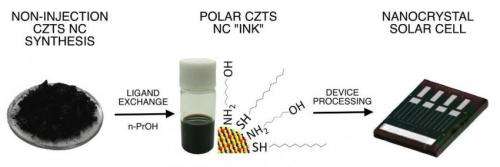April 15, 2014 feature
Solar cells made from polar nanocrystal inks show promising early performance

(Phys.org) —Achieving a balance between low-cost fabrication and high efficiency is key to the future success of solar cells. Over the past several years, researchers have been working on developing low-cost methods to manufacture solar cells. One of the most promising methods is solution processing.
In a new paper, Dr. Joel van Embden, et al., from CSIRO Materials Science and Engineering, Australia, have used a low-cost solution processing method to fabricate nanocrystal-based solar cells made from environmentally benign polar nanocrystal inks.
While previous solar cells made from nanocrystals have required the use of solvents that are highly toxic or contain high concentrations of organic contaminants, in the new study the researchers were able to use cheap, non-hazardous solvents instead, such as simple alcohols. Even at this early stage in their development, the solar cells exhibit efficiencies of up to 7.7% and appear to be promising candidates for future commercial applications.
"The greatest significance of our work is that it proves the ability to take cheap materials and process them into efficient solar cells using scalable methods and environmentally friendly liquids," van Embden told Phys.org.
As the researchers explain in their paper, the eventual uptake of solution-processed solar cells by the renewable energy market hinges upon both the ability to synthesize the required semiconductor 'ink' dispersions using scalable, low-cost methods, as well as the processing of these inks into devices using simple, benign chemistry. The new nanocrystal-based solar cells tackle both these challenges. Furthermore, the light-absorbing layer of these cells is made of nanocrystals composed of the inexpensive, earth-abundant materials copper, zinc, tin and sulfur.
The researchers made the "solar ink" by modifying the nanocrystal surface chemistry to impart a high polarity. This high polarity was achieved by sticking specialized organic molecules called ligands onto the nanocrystal surface.
The nanocrystal inks were then deposited onto conductive glass substrates and treated with selenium vapor using a process called selenization. This process transforms the nanocrystalline film into a microcrystalline film, which greatly enhances the films response to light. However, the degree of grain growth induced by this selenization process is currently limited. The researchers expect that this limitation is the most significant challenge facing nanocrystal-based solar cells.
The future direction of this research lies in pushing toward higher device efficiencies by tailoring the nanocrystal ink composition. The polar inks enable beneficial dopants and growth-promoting additives to be included. This development opens the door to complex ink formulations that are expected to be suitable for printing next-generation solar cells.
"We are in the process of developing multi-component nanocrystal inks, which contain various additives, each with its own role to play in improving the final solar cell's efficiency," van Embden said.
More information: Joel van Embden, et al. "Cu2ZnSnS4xSe4(1−x) Solar Cells from Polar Nanocrystal Inks." Journal of the American Chemical Society. DOI: 10.1021/ja501218u
Journal information: Journal of the American Chemical Society
© 2014 Phys.org




















